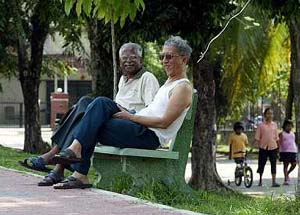Urban design wisdom from Malaysia
 Pavements and benches placed strategically within housing estates will encourage people to meet and interact. Photo from The Star of Malaysia.
Pavements and benches placed strategically within housing estates will encourage people to meet and interact. Photo from The Star of Malaysia.In "Building racial harmony: Architecture inside out," The Star of Malaysia features "maverick architecture lecturer Prof Dr M. TAJUDDIN M. RASDI who believes we should be building people-friendly neighbourhoods rather than glorious showcases to political egos. In the first of his monthly columns, the outspoken academic shares his views on how our physical environment can influence intangibles like racial and religious harmony."
From the article:
Wright (1867-1959) said buildings should be designed from the inside out; that is, the design should be driven by a building’s internal functions that reflect our customs, values, cultures and behaviours. But in this country, architects, clients and policymakers all want architecture as “object”, not architecture as a reflection of these aspects of users’ lives.
I maintain that this state of design and planning is straining ethnic relations in this country. There are three aspects to this issue: the design of the terrace house, how community facilities are planned and the architectural vocabulary used in buildings of national significance. ...
Let us now look at the larger picture of planning a housing estate. As I mentioned in last week’s interview, simply walking can help us deal with everything from physical, social, economic and environmental health to personal safety. Here’s how:
• Physical, economic and environmental aspects: Walking to shops, the kindergarten, school, means exercise, of course, and better health; furthermore, you save money on fuel and pollute the environment less.
• Social aspect: If you walk, you can take the time to greet or smile at neighbours instead of zooming past them inside your air-conditioned car with its tinted windows.
• Personal safety aspects: And, by getting to know everyone in this way, you would create a defensible space that strangers planning to commit crimes will find hard to breech. If housing estates were filled with people walking about, I can almost guarantee that criminals will be put off.
But how do we encourage a walking culture? Easily:
• Make pedestrian-friendly pavements mandatory.
• Make the planting of shady trees mandatory, too.
• Place wakaf (small huts) and simple furniture along streets to provide resting places.
• Make it easy for newspaper kiosks and goreng pisang stalls to set up by providing amenities for such small businesses that have the potential to create social hubs.
• Place schools, libraries, mosques, temples, community centres and some shops within true walking distance of clusters of houses so people are encouraged to walk rather than drive.
• Promote bicycling by providing proper pathways as well as bicycle parking spaces.
It is so simple. By planning for all these inexpensive features – and leaving out the royal palm trees and overly decorative lampposts – we can forge communities with naturally strong ties and racial interaction and integration.
Also see "We don’t have to live like this," from the previous week. Meanwhile, the U.S. papers are full of articles about starchitects saving the world... such as "Starchitects Invited to New Orleans Waterfront."
Index Keywords: urban-design-placemaking



0 Comments:
Post a Comment
<< Home